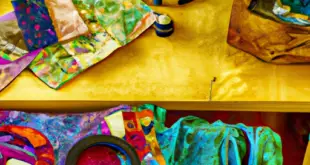Unlock Your Creativity: Explore DIY Screen Printing and Block Printing on Textiles
In today’s fast-paced and technologically advanced world, there is a subconscious desire for innovation and a need to express one’s creativity. DIY screen printing and block printing on textiles provide an engaging way to unlock your creative potential and bring your unique designs to life.
These age-old techniques offer a hands-on approach to textile printing, allowing you to explore your imagination and create truly one-of-a-kind pieces.
DIY screen printing allows you to transfer your designs onto various textiles, such as t-shirts, tote bags, and even home decor items. By using a mesh screen and a stencil, you can apply your chosen design and colors with precision and control. This process not only gives you the freedom to experiment with different patterns and styles, but it also allows you to create multiple prints of your design, making it perfect for small-scale production or personalized gifts.
The art of block printing, on the other hand, involves carving a design onto a block of wood or linoleum and then using that block as a stamp to print onto fabric. This technique offers a tactile and organic approach to textile printing, where each print bears the unique characteristics of the carved block.
Whether you prefer the versatility of screen printing or the traditional charm of block printing, both methods provide an exciting avenue for expressing your creativity and adding a personal touch to your textiles.
DIY Screen Printing: Bringing Your Designs to Life
Screen printing allows individuals to transform their designs into tangible and visually appealing creations on textiles through a do-it-yourself approach. This innovative technique involves transferring ink onto fabric using a stencil or a screen.
By creating a design on a transparent material, such as acetate or a specialized mesh screen, and applying ink through the screen onto the fabric, individuals can achieve intricate and vibrant patterns. The process begins by attaching the screen to a frame and placing it securely on top of the fabric. The design is then positioned on the screen, and ink is applied using a squeegee, spreading it evenly across the screen and through the open areas of the design.
As the ink is forced through the screen and onto the fabric, it adheres to the textile, creating a permanent and durable print.
One of the key advantages of DIY screen printing is its versatility. It allows individuals to print on various materials, including cotton, polyester, and even wood or metal. This opens up a world of possibilities for creative expression and innovation.
Whether it’s designing unique t-shirts, customizing tote bags, or adding a personal touch to home decor, screen printing offers a way to bring imagination to life. Moreover, this DIY approach empowers individuals to create one-of-a-kind pieces that reflect their personal style and vision.
By experimenting with different colors, patterns, and techniques, individuals can truly unlock their creativity and produce visually captivating designs. The satisfaction of seeing your own artwork come to life on a textile is not only fulfilling but also inspires a sense of accomplishment and motivation to further explore the realm of DIY screen printing.
The Art of Block Printing: A Hands-On Approach
The art of block printing offers a hands-on approach to textile design, allowing for the creation of unique and intricate patterns using carved blocks.
Unlike screen printing, which relies on a mesh stencil to transfer ink onto the fabric, block printing involves carving a design onto a wooden or linoleum block, applying ink or dye to the block’s surface, and then pressing it onto the fabric.
This technique dates back centuries and has been used in various cultures around the world. The beauty of block printing lies in its simplicity and versatility. With a few basic tools and materials, anyone can learn and practice this ancient craft.
Block printing allows for endless possibilities in design and experimentation. Artists can create their own intricate patterns, motifs, or even replicate traditional designs. The process of carving the block requires precision and attention to detail. Each line and curve is carefully carved out, resulting in a unique stamp that can be used to print an unlimited number of times.
The beauty of block printing lies in the imperfections and the handmade quality it brings to the fabric. The slight variations in pressure and ink distribution add character and charm to the final printed piece. Whether used for clothing, home decor, or art, block printing offers a tactile and artistic experience that can spark the imagination and inspire innovation.
Choosing the Right Materials for Your Textile Printing Projects
When embarking on a textile printing project, it is essential to carefully select the appropriate materials to ensure optimal results. The choice of materials can greatly impact the outcome of the print, as well as the overall durability and longevity of the design.
One of the key materials to consider is the fabric itself. Different fabrics have different properties that can affect the way the ink interacts with the surface. For example, a tightly woven fabric like cotton or linen will provide a smooth and even printing surface, while a loose weave fabric like muslin may result in a more textured and rustic look. Additionally, the weight and thickness of the fabric can also influence the final result. Thicker fabrics tend to absorb more ink, resulting in a more vibrant and intense print, while thinner fabrics may produce a softer and more subtle effect.
Another important material to consider is the type of ink or paint that will be used for printing. There are various options available, each with its own characteristics and advantages. For screen printing, water-based inks are commonly used as they are easy to work with, produce vibrant colors, and are environmentally friendly. However, they may not be as durable as other types of inks, especially when used on fabrics that will undergo frequent washing or heavy use. On the other hand, oil-based inks provide excellent durability and color saturation but require special solvents for clean-up and may emit strong fumes.
It is crucial to choose an ink that is compatible with the fabric and intended use of the printed textile to ensure a long-lasting and visually appealing result. By carefully selecting the appropriate materials for your textile printing project, you can unlock your creativity and explore the endless possibilities of DIY screen printing and block printing on textiles.
Exploring Design and Color Options for Your DIY Prints
One important aspect to consider when designing and selecting colors for your textile prints is the visual impact they will have on the viewer. Colors have the power to evoke certain emotions and create a specific mood.
For example, warm colors like red and orange can convey energy and passion, while cool colors like blue and green can create a sense of calm and tranquility. By carefully choosing the colors for your prints, you can enhance the overall aesthetic appeal and message of your design. Additionally, the use of contrasting colors can add depth and dimension to your prints, making them visually striking and captivating.
Experimenting with different color combinations can open up a world of possibilities and allow you to create unique and eye-catching designs.
When exploring design options for your DIY prints, it is important to consider both the composition and the subject matter. The composition refers to the arrangement of elements within your design, such as the placement and size of patterns or images.
A well-balanced composition can create a sense of harmony and visual interest, while an asymmetrical composition can add a touch of dynamism and excitement. It is also essential to consider the subject matter of your print.
Whether you choose to create a bold and graphic design or a delicate and intricate pattern, the subject matter should align with your personal style and the message you want to convey. By experimenting with different design and color options, you can unleash your creativity and create prints that are not only visually appealing but also reflective of your own unique vision.
Conclusion
In conclusion, DIY screen printing and block printing on textiles offer endless opportunities for creative expression. By bringing your designs to life through these hands-on techniques, you can create unique and personalized textiles that reflect your individual style and vision.
The art of screen printing allows you to transfer intricate designs onto fabric with precision and clarity, while block printing offers a more tactile and organic approach, allowing you to carve and print your designs by hand.
When embarking on a textile printing project, it is important to choose the right materials that will ensure the longevity and quality of your prints. From selecting the appropriate screens and inks for screen printing to choosing the right blocks and fabric paints for block printing, each decision contributes to the final outcome of your prints.
Additionally, exploring design and color options is crucial in creating visually striking and captivating textiles. Whether you prefer bold and vibrant colors or subtle and delicate patterns, experimenting with different design elements will allow you to unleash your creativity and produce truly unique textiles.
In conclusion, DIY screen printing and block printing on textiles provide a gateway to endless possibilities in the world of creative expression. By embracing these techniques and carefully selecting materials, you can bring your designs to life and adorn fabrics with your own unique imprint.
So, unleash your imagination, experiment with different design and color options, and let your creativity soar as you embark on this exciting journey of textile printing. The world of DIY printing awaits, ready to showcase your artistic prowess.
 printablelabelstemplate
printablelabelstemplate
